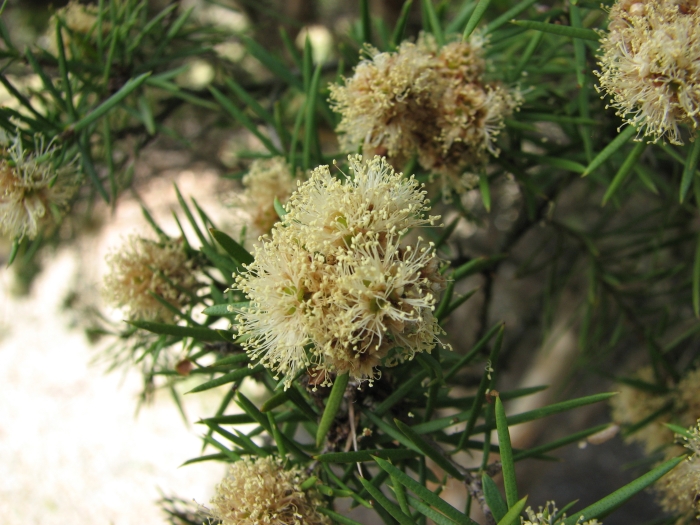Prickly-Leaf Paperbark
(Melaleuca nodosa)
Prickly-Leaf Paperbark (Melaleuca nodosa)
/
/

Melburnian
CC BY-SA 3.0
Image By:
Melburnian
Recorded By:
Copyright:
CC BY-SA 3.0
Copyright Notice:
Photo by: Melburnian | License Type: CC BY-SA 3.0 | License URL: https://creativecommons.org/licenses/by-sa/3.0 | Uploader: Melburnian | Publisher: Wikimedia Commons | Title: Melaleuca_nodosa.JPG | Notes: {{Information| |Description=Banksia plants, currently flowering in the Banksia garden in Kings Park ''Melaleuca radula'' '''Graceful Honeymyrtle''' |Source=own work, digital photograph |Date=14 August 2006 |Author=Gnangarra |Permission=Own work, attribut |













































Estimated Native Range
Summary
Melaleuca nodosa, commonly known as Prickly-Leaf Paperbark, is an evergreen shrub or small tree native to a variety of habitats including coastal heath, forest margins, and swampy areas in Eastern Australia. It typically grows to 10 m (30 ft) tall and is noted for its thick, papery bark that peels away in layers. The narrow, sometimes needle-like leaves are a distinctive feature, along with the profuse heads of yellow flowers that can appear as early as April or as late as January. The flowers are white to yellow and are arranged in dense heads or short spikes at the ends of branches that continue to grow after flowering, and sometimes also in the upper leaf axils. Flowering occurs mainly from September to November, peaking in October, but sporadic blooms can occur at other times. The woody, cup-shaped fruit capsules follow the flowers, clustering tightly along the stems.
Prickly-Leaf Paperbark is valued for its adaptability to cultivation, with potential as a hedging plant or for use in coastal gardens due to its tolerance to salt spray. It offers ornamental appeal with its striking bark and cheerful yellow blooms. In the garden, it requires full sun exposure and benefits from extra moisture, thriving in soils with medium to fast drainage. While not widely grown, it can be a unique addition to gardens, especially in regions with similar climates to its native Australia. Care should be taken to avoid overwatering, as it can tolerate dry conditions once established.CC BY-SA 4.0
Prickly-Leaf Paperbark is valued for its adaptability to cultivation, with potential as a hedging plant or for use in coastal gardens due to its tolerance to salt spray. It offers ornamental appeal with its striking bark and cheerful yellow blooms. In the garden, it requires full sun exposure and benefits from extra moisture, thriving in soils with medium to fast drainage. While not widely grown, it can be a unique addition to gardens, especially in regions with similar climates to its native Australia. Care should be taken to avoid overwatering, as it can tolerate dry conditions once established.CC BY-SA 4.0
Plant Description
- Plant Type: Shrub, Tree
- Height: 18-24 feet
- Width: 9-12 feet
- Growth Rate: Moderate
- Flower Color: White, Yellow
- Flowering Season: Spring, Summer
- Leaf Retention: Evergreen
Growth Requirements
- Sun: Full Sun
- Water: Medium
- Drainage: Medium, Fast
Common Uses
Bee Garden, Bird Garden, Butterfly Garden, Fragrant, Hedges, Hummingbird Garden, Low Maintenance, Showy Flowers, Street Planting
Natural Habitat
Native to coastal heath, forest margins, and swampy areas in Eastern Australia
Other Names
Common Names:
Scientific Names: , Melaleuca nodosa, Melaleuca juniperoides, Callistemon juniperinus, Melaleuca juniperina, Metrosideros nodosa, Melaleuca nodosa var. tenuifolia, Metrosideros gracilis, Metrosideros juniperina, Metrosideros juniperoides
GBIF Accepted Name: Melaleuca nodosa (Gaertn.) Sm.